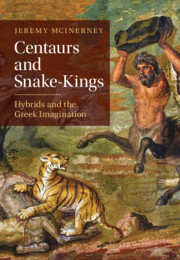Book contents
- Frontmatter
- Dedication
- Contents
- List of Figures
- Preface
- Acknowledgments
- Spelling and Orthography
- 1 Introduction: Encountering the Sphinx
- 2 ‘Welcome to Athens’: Theories of Hybridity
- 3 Hybrids around the Corrupting Sea
- 4 Hybrids, Contact Zones and Margins
- 5 Heads or Tails: Gorgons, Satyrs and Other Composites
- 6 Centaurs and Other Horses
- 7 Snakes and the Perils of Autochthony
- 8 Hermaphrodites and Other Bodies
- 9 Adynata, Ethnography and Paradox
- 10 Conclusions
- Bibliography
- Index
8 - Hermaphrodites and Other Bodies
Published online by Cambridge University Press: 16 August 2024
- Frontmatter
- Dedication
- Contents
- List of Figures
- Preface
- Acknowledgments
- Spelling and Orthography
- 1 Introduction: Encountering the Sphinx
- 2 ‘Welcome to Athens’: Theories of Hybridity
- 3 Hybrids around the Corrupting Sea
- 4 Hybrids, Contact Zones and Margins
- 5 Heads or Tails: Gorgons, Satyrs and Other Composites
- 6 Centaurs and Other Horses
- 7 Snakes and the Perils of Autochthony
- 8 Hermaphrodites and Other Bodies
- 9 Adynata, Ethnography and Paradox
- 10 Conclusions
- Bibliography
- Index
Summary
This chapter provides a discussion of the anxieties within (conventionally cisgendered) communities faced with the complex realities of transgender identities, sexual binarism and dysphoria. Ancient discourse tended to reduce this to a simple binary according to which conventional constructions of cisgendered bodies contrasted with a single representation of anomaly: the hermaphrodite. The story of Hermaphroditos, however, reveals that sexual hybridity and ethnic categorization (Karians and Greeks) operated in tandem and recursively: one group’s culture hero (as founder of marriage) become another’s intersex monstrosity. Hermaphroditos is only one example of a body undergoing sexual transformation, and other figures, such as Teiresias, Kaineus and even cross-dressing Achilles, illustrate that there existed a space for imagining alternatives to conventional categories. But an imaginative space is not a manifesto, and sexual anomaly (as it appears in ancient thinking) illustrates a trajectory of Greek culture: hybrids and anomalous bodies become partly decorative and, in literary works, interesting paradoxes, while their power to shock was largely relegated to the sphere of magic.
Keywords
- Type
- Chapter
- Information
- Centaurs and Snake-KingsHybrids and the Greek Imagination, pp. 231 - 259Publisher: Cambridge University PressPrint publication year: 2024

